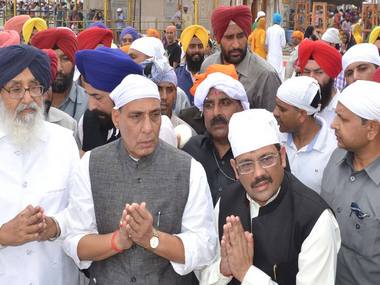Former Union Minister and senior BJP leader Harmohan Dhawan has a very distinctive style on Facebook. There are loads of family photos, for one. His cover photo shows his extended family beaming happily into the camera; lower down on the page there are a couple of images of him hugging his wife on her birthday. Besides this, there are the requisite photos of him gracing Eid celebrations, as well as scan of flattering newspaper clippings. It’s not obvious from a single glance the painstaking effort that goes into maintaining Dhawan’s Facebook profile. According to an article in the Indian Express, the politician has his personal secretary take a print-out of all his notifications. Dhawan then dictates answers to the questions while the secretary types them out and responds on the Facebook page. [caption id=“attachment_1047583” align=“alignleft” width=“380”]  Rajnath Singh meeting people. Image courtesy Facebook.[/caption] It’s an entertaining image, but a telling one. Dhawan is one of the many Indian politicians who are refusing to be left behind on the social media wave. They are being urged on by their parties in this, as well. BJP, in its new bid to garner the ‘first time’ voter, has made its stance on the importance of social media very clear. Last month , the BJP held a workshop for technocrats and functionaries associated with the party to chalk out a strategy for reaching out to them through digital, mobile, Internet and social media. “We realise that you cannot win polls only by reaching out to people through social media but this is definitely a tool which can help in the process. The use of digital, mobile and Internet technology will also help us build an atmosphere in favour of the party,” a BJP leader said. But not all efforts are as successful as Dhawan’s. While the bigger BJP leaders, such as Rajnath Singh, boast of Facebook pages with thousands of ‘Likes’, the point of these pages might escape the coveted first time voter. They mostly consist of press releases and photos of the politician in question with Narendra Modi, or at events where they cut ribbons and smile. Take Rajnath Singh. While the leader boasts of almost 60,000 Likes, his Facebook feed reads like that of an excruciatingly dull cousin, or a distant relative who just discovered the internet. ‘Going to Sangrur (Punjab)’, ‘Had a meeting with Leader of Opposition, Sri Lanka, Mr Ranil Wickramasinghe’, ‘Going to Jashpur (Chhattisgarh)’, are his last three updates. Exactly what is a follower supposed to do with this information beyond being impressed by the fact the BJP president goes places and meets people? In other examples, it also seems to go off-track. Take the example of Kuldip Singh Yadav Nirala, a BJP leader who has 67 Likes on his Facebook page, which proclaims him to be “Politician with BJP. resident of Bihar & Jharkhand State of India.. State EX- Vice- President (ex-serviceman Wing BJP), Jharkhand State.” His last five posts are ungrammatical and annoyed posts about the Congress. The five before that are paeans to Narendra Modi’s nationalism. In fact, a quick scan reveals that at no point does Nirala speak about the BJP’s achievements, much less his own. At the end, we’re left unsure whether Nirali is really a member of the BJP at all, or just a Modi supporter with an identity crisis. Satya Pal Jain, the chairman of the National Legal Working Group of the BJP, on the other hand, sticks to providing information on his stances on national issues as well as linking to interviews (the latest being a face-off with Arnab Goswami) in both Hindi and English. He recently completed four years on Facebook. Another BJP member on Facebook is Sanjay Tandon, the Chandigarh BJP president. Much of his Facebook page is standard - a cover photo of Modi and him looking lovingly at each other, the occasional Congress-bashing, a complete lack of any statements on progress made or plans for his constituency. One status reveals the hidden poet: “The foul smell from the verbal diarrhea of certain irresponsible people is polluting the #patriotic atmosphere of the #country.” Charming imagery. Facebook has also gone very wrong for the BJP in recent times. A page claiming to be one of the Gujarat BJP showed a a semi-nude picture of Nandana Sen, juxtaposed with another picture with Nandana with her father Amartya Sen. In an attack on Sen, the accompanying message said: “Mr Amartya Sen, first manage your home and daughter, which would be enough for you. There are plenty of Indian citizens to decide upon country and Modi in India. We do not need advice from a senile foreign national. Shame, you can’t manage your daughter and talk of Modi.” Gujarat BJP was quick to distance itself from the page. “This is not our official page,” said Harshad Patel, the media cell convenor of Gujarat BJP. A similar stand was also taken by Parag Seth, convenor of Gujarat BJP Communication Cell. “Our official page address is Facebook.com/BJPGujaratofficialpage,” Patel pointed out. Besides this, the Facebook pages also turn quiet after polls are over. A report in The Hindu pointed out “Politicians - who had enthusiastically taken to new media to reach out to newer, younger and more tech-savvy audiences during the recent elections- appear to have fallen off the social media bandwagon.” The gaping hole in the BJP’s ‘social media’ initiative so far is that while there is some dutiful updating of their activities, there is little to no ’engagement’ with their followers. Having a conversation or debate with voters is perhaps the biggest advantage to being on Facebook. And if this is being ignored, what is the likelihood of a ‘Like’ turning into a vote for the party?
The BJP might be focusing on social media with an eye on the elections, but the Facebook pages of their politicians leave much to be desired
Advertisement
End of Article


)
)
)
)
)
)
)
)
)



